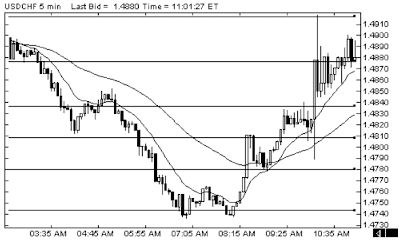Monday, December 21, 2009
The System of Forex Intraday Pivots Trading - HOW THE SET-UP SYSTEM WORKS
After you have calculated the pivot numbers for the day, place horizontal lines on your 5-minute and 1-hour charts at the pivot numbers for the day, or at least as many lines as your chart gives you room for. It should look something like this:
The lines in the above illustration represent five of the nine calculated numbers. On this five-minute chart, that was all there was room for. The nine numbers are:
R2,M4,R1,M3,Pivot,M2,S2,M1,S1
There are several basic ways to trade pivot numbers. Some look for the prices to move to the higher end, and then sell in the upper third of the scale, or buy in the lower third of the scale of numbers (S1, M1, and S2).
However, in forex, the number of pips (points) that the currency will move in a 24-hour period is usually substantial. This means that a move from the pivot or even the M2 number down to S2, M1, or S1 could represent 40 to 100 pips. If this is true, in USD/CHF, that is worth between $272 to $680 per lot traded. Therefore, to ignore the move down from this area to the projected low of the day could represent losing out on a good opportunity.
Additionally, the currencies are the most trending markets in the world, and frequently they do not stop if they reach these lower levels. Therefore, to look to buy at these low points can be dangerous unless you have a clear reversal pattern in place, or some other criteria for a reversal being met.
Others look for a break of the pivot and trade it lower or higher to the S2 or R1 numbers, take a portion of the profit, and leave the rest anticipating a continued move to either S1 or R2. The system I use is an extension of this method of trading pivots. I will present the method in two parts. The first application is simply trading the pivots with NO INDICATORS. Then the second application is to utilize the MOVING AVERAGES and MACD. In this way, you will see that the most important aspect of the system is the relationship between price and the pivot numbers. Secondarily, and of lesser importance, are the indicators.
The reason for this is because indicators tend to lag behind the action. If you follow only indicators, you will frequently find yourself in “NO MAN’S LAND.” This is that area in the middle between two points of support and resistance. The price can either continue on to the next point or reverse and go back to where it came from. This is the worst possible place to enter a trade, and yet that is where indicator trading often puts you. The best place to enter a trade is as close to support or resistance as possible. Obviously, if you are buying, you want to be sitting right on top of support and if selling, right below resistance. (Peter R.Bain and Dr. Brent Strouse.)



0 comments:
Post a Comment